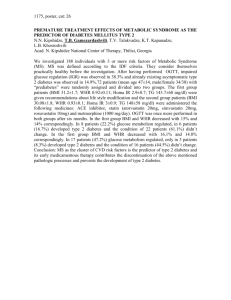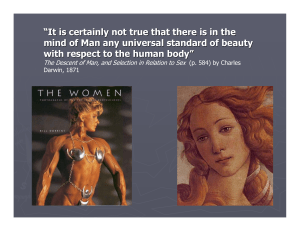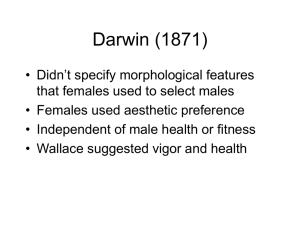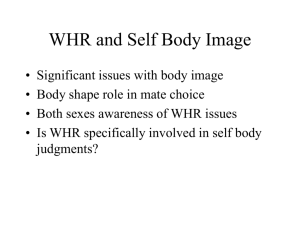Bases for physical attractiveness: male perspective
advertisement
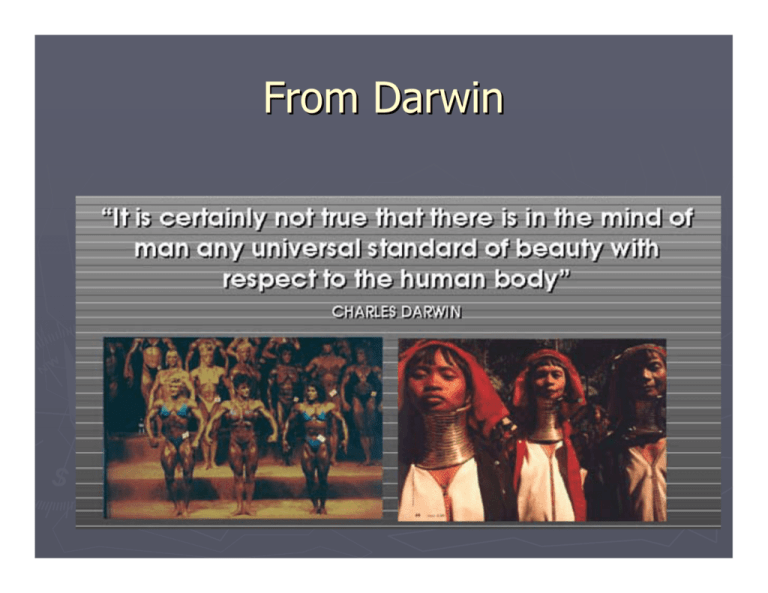
From Darwin Examples of Arbitrary Cultural Standards Arbitrary Cultural Standards Arbitrary Cultural Standards Beauty is in the eye of the beholder, or is it? ► The standard claim is that conceptions of beauty are culturally determined and therefore arbitrary. ► Research over the last dozen years or so reveals that how we evaluate beauty in the human body appears to be based on a universal set of standards. Therefore, some conceptions of beauty are not culturally determined. What is Beautiful? Relative and Absolute Standards in Attractiveness ► Universal model: holds that there are absolute standards that people use to assess attractiveness ► Assortative model (like attracted to like): holds that standards are relative to the viewer. That is, we are attracted to those who are similar to us. Also known as positive assortative mating. ► We will begin with the universal (or absolute) and follow with the assortative (or relative) Bases for female physical attractiveness ¾General Symmetry: low fluctuating asymmetry (applies to males also) ¾Body form Waist to hip ratio of approximately 0.7 (?) ¾Face Average (applies to males also) small lower jaw (nasion to chin) high upper and lower lips small mouth (width) large eyes light skin homogenous skin texture Symmetry How symmetry is measured Symmetry measures: 1 Symmetry measures: 2 Symmetry measures: 3 Symmetry measures: 4 Symmetry measures: “What? Me Worry?” Physical development and symmetry are regulated by: growth rates hormone levels nutrition disease 9The level of symmetry is a measure of developmental stability. 9Developmental stability is an indication of an individual's ability to withstand genetic and environmental stress during growth. 9High FA is associated with increased morbidity and decreased heterozygosity Symmetry is positively associated with ► Stature Tall males less asymmetrical (positive association) Small females less asymmetrical (negative association) ► IQ ► Number of lifetime partners and RS (males & females) ► Disease resistance ► Running speed ► Aggression ► Depression Source: JT Manning et al., 2002, Evolution and Human Behavior Facial Averageness Examples: facial averageness (Asian) Creating a facial average (N. Amer.) Average plus reduce jaw and peaked lips Averageness is associated with high levels of heterozygosity which, in turn, is associated with enhanced pathogen resistance. That is, average looking people tend to be healthier. Male Attractiveness and Specific Facial Features ► Prominent cheek bones and longer lower faces are both judged as attractive in males. ► When these two factors are combined a masculinity index is created, and this index is more strongly correlated with attractiveness than cheekbone or longer lower face alone. ► Finally, male facial symmetry and the masculinity index were correlated. Source: Scheib, Gangstead, and Thornhill “Facial attractiveness, symmetry and cues of good genes. Proc. R. Soc Lond. B (1999) Feminine and Masculine Faces ► Males favor women with feminine faces Small chin and high cheek bones Fuller and more peaked lips Large eyes (relative to face) ► Females seem to favor males who are slightly to moderately facially masculine but note extremely so Chins broader and longer Large brow ridge Waist to hip ratios WHR is a reliable index of age, hormonal status, parity, fecundity, and health. Before puberty boys and girls have similar ratios. However, with females pelvis widens and fat is deposited on hips and thighs at puberty. Healthy women have ratios of 0.67 to 0.80 while healthy men have 0.80 to 0.95. For attractiveness, ideal for men is 0.90 and female ideal is 0.7 (for Western populations only). Waist to Hip Ratio: standard stimulus set WHR and female mate value WHR increases with each pregnancy and increases slightly with age. However, a 17 year old will have nearly the same WHR as a 22 year woman and at menopause it reaches the level of a male's WHR (about 1). High WHR is strongly negatively associated with the probability of conception and positively associated with age. WHR ratio and health correlates High WHR in women is a sign of: • menstrual irregularity • Hirsutism (abnormal growth & distribution of hair) • elevated plasma triglycerides • diabetes and insulin intolerance • hypertension • stroke • gall bladder disease • reproductive cancers (endometrial, ovarian, and breast) WHR and Behavioral Correlates in Women ► Positively correlated with age of first intercourse. ► Negatively correlated with number of lifetime sexual partners and EPC’s, Examples: 0.7 WHR (the more things change, the more they stay the same) Further example of WHR’s WHR of 0.7 a reflection of Western standards? ► Recent research by anthropologists reveals that a WHR ratio of about 0.8 is preferred in the following ethnic groups: Hadza Shuar Machiguenga ► ► ► This is greater than the 0.7 ratio reported in the west. May be a consequence of living in a food short and/or high pathogen environment which suggests that men are concerned with energy status when it is relevant (i.e., not relevant in the West but relevant in tribal populations) What about BMI? Additional research in the West suggests that BMI is more important than WHR. The problem with BMI and WHR is that they are strongly correlated with each other. Therefore it is difficult to determine which is the factor that influences perceptions of attractiveness in human body form. Brits & SA Zulus Brit Zulu & SA Zulus BMI/WHR and Culture “Changing perceptions of attractiveness as observers are exposed to a different culture” B. Martin J. Toveé et al. Evolution and Human Behavior (2006) Brits of African Origin & Brit Zulus Local Conditions for SA Zulus: factors underlying preference for a high BMI Poverty & Hunger: People in rural South Africa are living in a low-resource, economically deprived society. Fifty-six percent report going hungry, and most households do not have electricity, running water, or significant amounts of household durable goods. In South Africa a higher female body weight is perceived to reflect affluence, high status, and good health. It is therefore not surprising that our results suggest that a higher female BMI is regarded as attractive. Health Problems: These preferences may be reinforced by the current health problems prevalent in South Africa. There are long-standing problems with infectious diseases, including lower respiratory tract infections, meningitis, diarrhea, septicemia and TB, which, when combined with low levels of immunization, make potential infection a serious possibility. The health consequences linked to these serious diseases include weight loss, and this is reflected in the perception that a lower body mass may signal potential parasitic infection or disease. Conclusions of British and Zulu Study ► Brits have a preference for lower BMI than South African Zulus ► When SA Zulus are reared in Britain their preferences for BMI move from that of native SA Zulus toward native Brits ► It seems to be the case that BMI preferences are influenced by to dietary and health issues and culture. A final male attribute SHR: shoulder to hip ratio an introduction to a male sign of fitness ► Measurement: hip measured as largest circumference around the hips and buttocks. shoulder measured as greatest width of should blades with arms at sides. ► Results: men ranged from 1.03 - 1.40, mean of 1.18 women ranged from 0.9 - 1.22, mean of 1.03 SHR 1 of 2 SHR in men: behavioral correlates ► Negatively correlated with age at first sexual intercourse (narrow shoulders=later first sex) ► Positively correlated with: reported number of sexual partners EPC (extra pair copulations) or cheating on your own partner (broad shoulders=more infidelity) Attractiveness ratings by women SHR 2 of 2 Height and Attractiveness ► In the west males prefer females who are shorter than average while females prefer males who are taller than average. ► Correspondingly, tall men have higher RS than shorter males and shorter females have higher RS than taller females. ► In rural Gambia this relationship seems not to hold. Tall women had higher fertility & higher survivorship of their children While taller men were only very slightly more likely to have higher RS than shorter men Sear “Height and Reproductive Success”. Human Nature 17(4) 2006. Assortative or relative models: “Like seeking like” ► ► ► ► ► People marry those who resemble themselves Known as positive assortative mating Couples correlate or resemble each other for most traits (height, weight, personality, social attributes, hair color, etc.) Presumably, this optimizes outbreeding to avoid excessive genetic variance that would interfere with coadaptive gene complexes You can’t always get what you want: while people who have greater symmetry, etc are more attractive, people tend to marry those who are physically most like them. Conclusion ► There are universal standards of beauty which include: Symmetry, WHR (or perhaps BMI), averageness, SHR, etc These are measures of health and other factors associated with fitness They also may vary with environmental factors (e.g., BMI preferences in Zulus and Brits) ► At the same time like tend to marry like (positive assortative mating) ► Both factors affect human mate choice

